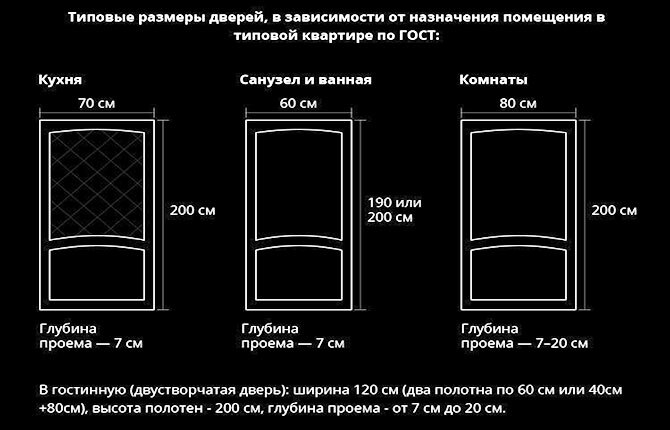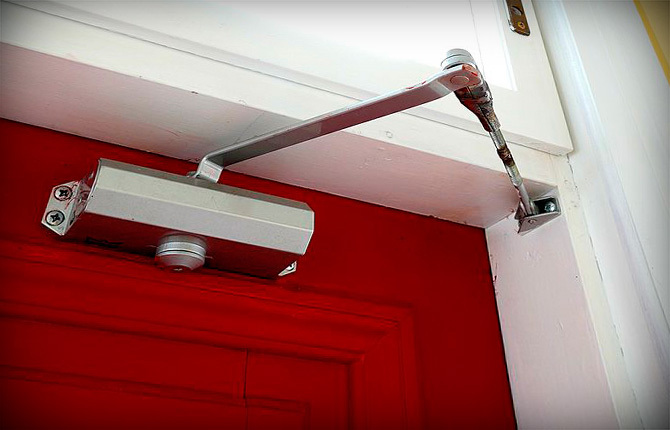Not everyone knows how to drain water from a stretch ceiling. In the event of a flood, this is necessary in order to avoid subsequent expenses for repairs. There are several ways to drain water from a stretch ceiling without damaging the material. This can be done by everyone on their own. The main thing is to drain carefully so as not to touch the material, not to spoil the appearance of the stretch coating.
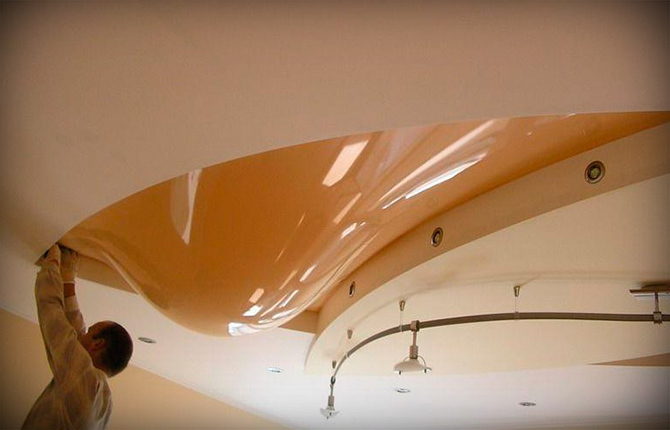
The content of the article:
- Water in the stretch ceiling - what to do first
-
How to remove water from a stretch ceiling yourself
- With special valves
- With holes for lights
- What if there are no holes
- Cleaning, drying
- Common Mistakes
Water in the stretch ceiling - what to do first
Many begin to panic if they are flooded by their neighbors when the houses have stretch ceilings. But not everyone knows that you can get out of the situation without spending extra on repairs. There are even videos showing how to drain water from a stretch ceiling. This can be done on your own immediately after the flood, without wasting time looking for workers.
When flooding occurs from above in the presence of a stretch ceiling, a bubble forms. Liquid, getting into the canvas, accumulates in one place. It sags like it's bursting. The tension material can withstand about a hundred liters, so you don’t have to worry that the bubble will burst, everything will spill out. The main thing is to notice a set of liquid in time, to warn the neighbors.
You can drain the water from the stretch ceiling after flooding yourself. But there are also workers who are engaged in their installation and repair. You can call the company's employees, ask them to properly drain all the liquid from the tension fabric.
If a person wants to drain all the water on their own, certain steps must be followed:
- First you need to turn off the electricity. Otherwise, the work may lead to a short circuit in the wiring, and other consequences.
- After turning off the electricity, you need to go to a neighbor, because there is a risk that water continues to flow, accumulate in the ceiling. The sooner you can report a flood, the more likely you are to avoid repairs. It is necessary to warn the neighbors below in case the bubble does not stand up, bursts.
- You can drain the water yourself or contact the company. In the second case, you need to call there or leave a request.
- You also need to remove all things that may be affected by flooding. It is better to take them to a distant room, where the liquid will not flow in case of a bubble puncture.
- The remaining furniture in the room should be covered with a waterproof film, especially wood. This will help to avoid damage to the wood in case of flooding.
- Prepare a container into which you can drain the liquid from the ceiling. It is advisable to take deep basins where a lot of water can fit.
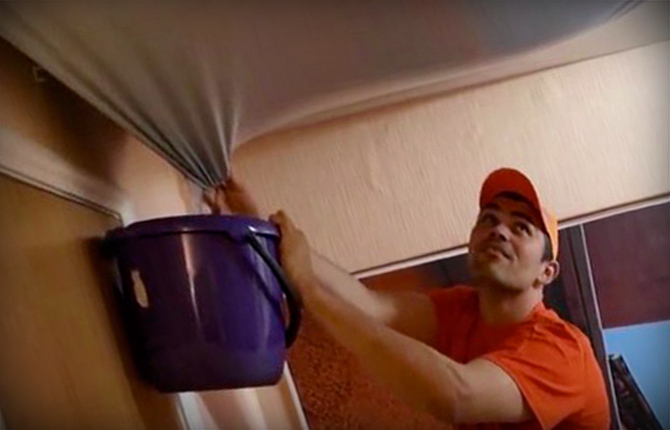
Having done everything, you can drain the water. This must be done carefully, slowly, to avoid puncture, damage to the tension material itself.
How to remove water from a stretch ceiling yourself
It is not possible to drain water from the ceiling on your own. You will need the help of other people. Therefore, it is better to invite one or more friends with you. It will be possible to merge successfully if you follow the sequence of steps that are performed slowly, with care:
- First you need to inspect the canvas, select a hole to drain the water. For this, the place where the lamp is attached is suitable. It can not be removed, except for the gap from where water will flow. But if the hole for the lamp is far from the bubble, it is better to choose one of the edges of the ceiling. To do this, you will need to make drainage in the place where the tension material is attached to the wall.
- If the edge of the ceiling has been selected to drain the water, it is necessary to remove all lighting elements from the tensile structure. Otherwise, they may fall, break.
- Before draining the water, you need to substitute a structure on which you can stand under the place. A stepladder is suitable for this.
- To remove water, you need to prepare a hose, a container. You need to insert one of the ends into the hole, and place the other in the container.
- Next, you will need the help of another person. In order for the liquid to flow smoothly over the tension coating, it is necessary for one assistant to push the bubble, and the second to hold the hose, the container. This can take a long time. But there is no need to hurry, to press hard on the sagging stretch fabric. Otherwise, the liquid may spread across the floor, flooding the neighbors from below.
- If a hole from under the lamp was chosen to drain the water, the hose can not be used. In order to remove all the liquid, you need to move the bubble to the hole, slowly drain it.
After the water has been drained, it is necessary to dry the stretch fabric. Only after complete drying can you hang lighting elements. It is recommended not to turn on the electricity for the first couple of hours after the procedure. Also, after the problem is eliminated, pits and irregularities may remain. No need to try to align the stretch fabric yourself. It will take the desired shape after complete drying.
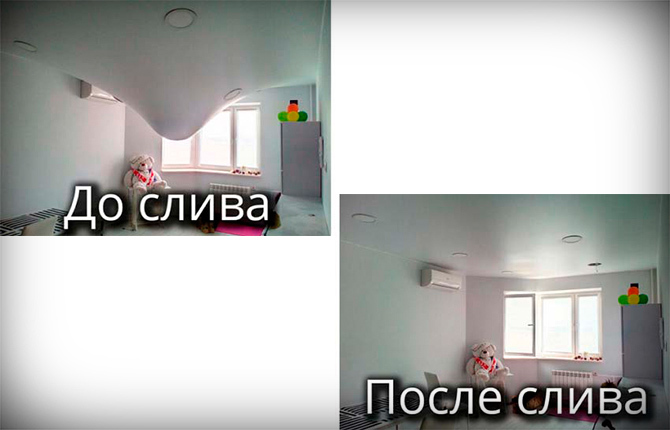
With special valves
Some stretch ceilings have special valves through which water can be removed. They are designed for this, so there will be no problems with opening. To remove the liquid from there, it is necessary to open the valve, after substituting a container under it. You can use a hose.
To remove all liquid from the tension surface, carefully push the bubble to the hole. This should be done slowly, not with sharp objects. A mop with a soft nozzle will be a suitable tool. It will be difficult to damage the stretch fabric. She has no sharp protrusions.
To thoroughly dry the canvas, to avoid the occurrence of fungus, mold, and other problems, it is necessary to remove it. After that, it will be possible to call a service that will pull the ceiling back. This action will allow you to dry the tension material evenly, as well as level the place of sagging, return it to its former appearance. It is also recommended to remove the canvas with the help of service workers, otherwise there is a risk of damaging it, scratching it, stretching it even more. The company's employees will be able to remove the tension material in a few minutes, and they will also do it correctly and accurately.
With holes for lights
On the ceiling there are places for mounting lamps. If there are no valves, you can use them as a hole through which it is convenient to drain the liquid. In order to eliminate all the accumulated water through them, it is first necessary to turn off the electricity in order to avoid a short circuit, electric shock. To remove all the water, you need to prepare containers, a stepladder. You can control the flow, jet of water with a hose. It will also be necessary if the lamp is not attached to the wall.
If there is liquid residue after draining through the hose, you can push the protrusions with the same mop. After all the liquid has been removed, it is recommended to remove the coating and dry it. This will get rid of irregularities, sagging at the place of accumulation of water. To do this, it is recommended to call the company's employees, since the material can be damaged, and then the ceiling will have to be pulled again.
What if there are no holes
If there are no holes for lamps on the ceiling, you will have to drain the water through the free edge. It can be unscrewed independently using construction tools. The main thing is to release a small piece of material so as not to stretch, to avoid damage. There are several types of canvas, on which the method of cutting it depends:
- The first is the harpoon coating. It features a hard, folded edge.
- The second is clip-on. Its edge is attached to clips, which can be unscrewed with a flat screwdriver or spatula.
- A glazing bead coating means a profile into which the canvas is driven with a spatula.
You can see the name of the material in the instructions for the ceiling. The method of opening the edge will depend on this. The type of coating affects how the canvas will be used in the future, because if the cutting is incorrect, the entire structure can be damaged.
Reading: Stretch ceiling ventilation
Cleaning, drying
After draining the liquid from the ceiling, it sags, becomes uneven in places. In order to return it to its former shape, it is necessary to dry the canvas. You can do it yourself, but you will need a building hair dryer. It can be purchased at a hardware store. But also the company that stretches it is engaged in drying the canvas. You can leave a request for drying to be carried out by employees of the organization.
If there is a building hair dryer at home, then you need to set it to the lowest power mode. Dry the canvas should be at a distance of 20 cm from it. Direct the device over the entire material so that it dries evenly. You also need to walk along the entire canvas to eliminate excess water.

It is not recommended to dry the wet ceiling yourself. First, it takes a long time. Secondly, self-drying does not guarantee complete recovery of the material. Employees of the company do it faster, more correctly. Therefore, after them, the chance of restoring the canvas is higher.
Common Mistakes
Many underestimate the difficulties that can arise when eliminating fluid from a structure. At first glance, it may seem smaller than it really is. Because of this, people cannot choose a container, a way to eliminate liquid. In order to get everything seamlessly drained, it is better to take a container deeper in advance. This will prevent water from spreading around the room.
Also, many make the mistake of choosing a hole to drain water. This can cause a rupture of the bubble, the formation of new bulges. It is better to choose a far hole so that the protrusion is evenly distributed over the surface, it was possible to carefully drain the water from it, and not spray it on the sides.
Some more try to level the uneven ceiling on their own with the help of improvised means. Doing so may damage the material. The thinner it is, the higher the chance of perforating the canvas, ruining its appearance.
Despite the fact that you can drain the water yourself, employees of stretch ceiling installation companies do not recommend doing this. If you rush, do not follow the recommendations, you can ruin the structure, flood the neighbors from below. In addition, inaccurate actions lead to damage to the material. It can be perforated, scratched, stretched.
Turning to the employees of the special services, all this can be avoided. They will remove water from the structure, dry it evenly. When stretching ceilings, some companies offer to issue an additional service in case of flooding.
And how did you get rid of water in the interceiling space? Share the link on social networks and bookmark the article.

